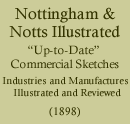< Previous | Contents | Next >
HUMBER & CO., LIMITED,
Manufacturers of the Celebrated "Humber" Cycles.
Works :-BEESTON (Notts), WOLVERHAMPTON, and COVENTRY.
| Depots | { | LONDON : 32 Holborn Viaduct, E.C. Telegrams. " Humber, London." |
| { | BRIGHTON : 66-68 Preston Street. Telegrams, " Humber, Brighton." | |
| Registered Offices: 32 Holborn Viaduct, London, E.C. | ||
| Subsidiary companies | { | Humber & Co. (America), Ltd, Westboro', Mass., U.S.A. |
| { | Humber & Co. (Russia), Ltd, Moscow. | |
| { | Humber & Co. Portugal), Ltd., Lisbon. | |
| { | Humber & Co. (Sweden), Ltd., Malmo. | |
| { | Humber & Co. (Denmark), Ltd., Copenhagen. | |
| { | And Agencies in All the Principal Cities of the World. | |
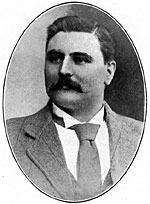
Mr. H. Belcher.
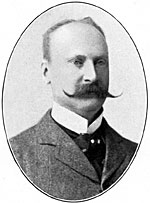
Mr. M. D. Rucker.
THE history of industrial progress from its earliest period, presents no more memorable or remarkable chapter than that which embraces the inception and development of the cycle-manufacturing trade of this country, a trade of worldwide extent and importance, for which, perhaps, the only parallel to be found is supplied in the first introduction of steam-power for railway purposes. Even this example — unique in every sense — fails to convey an impression of the universality of the most popular form of locomotion yet devised by the wit of man, and which to-day, claims its votaries in millions of the human race wherever a pathway can be found on which a wheel can travel. With the invention of the cycle was opened a new and important field of enterprise, and with the subsequent rapid strides of improvement must be inseparably associated the great firm of Humber and Co., whose name for thirty years has maintained its pre-eminence in the very foremost rank of makers, and has been invariably accepted as an absolute guarantee of perfection in every machine hall-marked with their world-famous brand.
The History of the Firm.
In the year 1868, Mr. Thomas Humber embarked in the business of cycle manufacturing in accomparatively small way at Nottingham, and there was subsequently joined in partnership by Mr. Marriott, and later by Mr. Cooper, the firm trading then as Humber, Marriott and Cooper. Ten years later the business was transferred from the original site to Beeston, about four miles south-west of Nottingham, and it is interesting to note that at that time it was only considered necessary to erect one comparatively small factory to accommodate the eighty men then employed, which has since been extended to its present commodious size, providing convenience for a large industrial army of some 2,000 hands. In 1886, the firm was reconstituted as a limited liability company, and in the following year the Coventry factory was established. Still advancing their policy of extension, and in order to meet the continuously increasing demand for the Humber machines, the Company acquired in 1888, "The Ashes" Factory, at Wolverhampton, to which in 1896 it was found necessary to add a second factory in Poultney Street, in the same town, a brief description of both buildings appearing at a later stage of our notice. In 1896 also, the Humber and Co. Extension, Limited, was formed as auxiliary to the parent concern with a capital of £200,000, to work the wholesale and retail sale departments of Humber and Co., Limited, on a separate basis from the manufacturing branches. he same year witnessed till further important developments of the business, factories being established in Westboro', Mass., U. S. A.; Moscow, Russia ; and Lisbon, Portugal, since increased by the erection of additional works in Copenhagen, Denmark, and Malmo, Sweden. With this condensed outline of the rise and progress of the vast business, we next proceed to describe the salient features of
The Beeston Works.
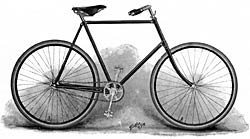
Nos. 5 and 6.—Special Light Roadster (Beeston and Wolverhampton make).
Passing into Humber Road, distant some ten minutes' walk from Beeston Station, on the Midland Railway, the visitor is at once impressed withthe magnitude of the establishment, of which the most striking portion that first attracts attention is the exterior of the newly erected offices, which alone contain a floor area of 8,000 square feet, and are replete with every modern convenience, are lighted throughout by electricity, and provide commodious accommodation for the work of the clerical, managerial, and administrative departments. Flanking the offices is the right wing, an immense structure 400 feet in length, the buildings situated on the extreme left comprising the mess rooms, in which the workpeople have their meals, also sheds wherein they store the cycles which many of them use in riding to and from the factory. Beyond the buildings is a spacious recreation ground laid out for cricket and football, needless to add, a widely-appreciated institution with the employees. The left wing of the main building is succeeded by the Turnery, this portion of the premises exceeding 600 feet in length.
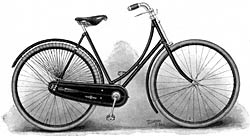
Nos. 19 and 20.—Ladies' Safety (Beeston and Wolverhampton make).
On entering the interior of the Factory, the visitor is first conducted to the Foundry, a spacious building devoted to the manufacture of the various lugs and joints which comprise the framework of the cycle. These are composed of a special combination of materials known only to the firm, and after casting, the parts are annealed by a particular process, occupying several days in completion, resulting in the production of a metal so admirably, fitted to withstand the strains to which it will afterwards be subjected, that it is even superior to the finest steel forcing's for the work it has to fulfil. Next to this is the Forge Shop, where the actual wearing parts, such as cones, axles and chain rings are stamped under enormous dies, out of finest steel. The various parts, as turned out from the Foundry and Forge Shop, are then transferred to the Turnery, which must be designated the most interesting department of the works. This immense structure is over 300 feet in length, 50 feet in width, and is 24 feet in height. It is lighted by thirty-five windows, situated in one row in the left side wall, and also by the roof which is supported by 105 columns. Extending the entire length in well-ordered arrangement are erected machines for turning, drilling, boring, milling, etc., and some idea of the costly nature of the plant laid down may be estimated from the fact that the machinery and tools in this department alone are valued at upwards of £50,000, and embrace every appliance that experience can suggest, embodying all the latest improvements in mechanical science for economising labour and augmenting the efficiency of the work performed. Each part handled in this department is made absolutely true to a gauge, and all parts are perfectly interchangeable. The perfection of accuracy attained is exemplified in the case of the "Humber " bearings, which can be adjusted to 1000th part of an inch, and the chain wheels can be lined with almost equal precision. This excellence of workmanship is produced by strictly tabooing all piecework, and by the firm paying such wages as enable them to obtain the best men in the engineering trade. It may also be remarked in connection with this department that a staff of experts is constantly engaged in designing still further improvements in plant and machinery, with the object of even increasing the reputation of the Humber manufactures.
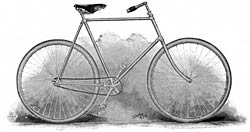
Nos. 9 & 10.—Special Aluminium Safety (Beeston & Wolverhampton make).
Following the various processes in their usual order, the wearing parts after leaving the Turnery, are subjected to the special "hardening " previously referred to, and which constitutes one of the most important of the firm's own exclusive trade secrets.
Next in order are the fitting departments in which are made the frames, forks, stays, etc., and in this portion of the factory the tubing is first subjected to a severe test—to ensure that it is free from defects, and is then fitted into the joints of the frame-work. When the frame is fitted together, it is again tested, and subjected to certain operations, which ensure its being mathematically true to the drawing, even to the smallest fraction of an inch. The filing-up process follows, the frames, forks, etc., when made being carefully gone over with smooth files and afterwards with emery cloth, the excellent surface thus produced before enamelling accounting to a certain extent for the distinguished appearance which the Humber cycles present when finished. The filing-up department is 170 feet by 40 feet, and adjacent are several newly erected shops each 200 feet in length, and now fully equipped with the requisite plant as additional fitting shops.
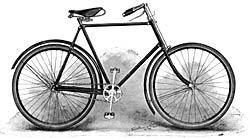
Nos. 1 and 2.—Roadster Safety (Beeston and Wolverhampton make).
The Enamelling Department comprises seven large rooms, each devoted to a separate process. Here again the firm possess a valuable trade secret for compounding the "Humber" Enamel, which is produced from a variety of ingredients, the combination of which is known only to themselves. It is also applied in several coats, which differ in composition from each other, and afterwards the frames are stoved at a temperature of some hundred degrees for many hours. Passing onwards, the glazing shop is entered, and here all the parts requiring plating are glazed on spindles by machinery constructed on the most recent principles, the shafting being underground. This process completed, the parts are conveyed to the Plating Shop, which is considered by experts to be the finest in England, and are afterwards passed on to the Polishing Room adjoining.
Other departments included in a tour of inspection are the Wheel Making Shop, 400 feet in length; the Gear Case Shop, 200 feet long; stores for Rims and Wheels, and the Finishing Shop. In the latter, or final stage, every part is thoroughly examined before the cycles are put together, so that it is practically impossible for a machine to leave the works in anything but a perfect condition. Another recent addition to the works may be remarked in the new Packing Shop, a room 200 feet long, in which the crates for the conveyance of machines are manufactured, and where they are put up ready for transport.
Motive force for the machinery is supplied by five powerful engines, fed from enormous boilers, to which, notwithstanding their large dimensions (being about 8 feet in diameter by about 30 feet long), the firm find it necessary to add to the number laid down, in order to cope with the increasing demands of the works.
The organisation of the vast establishment is complete in every detail, including in its general arrangements an efficient Fire Brigade fully equipped with every appliance for promptly dealing with a conflagration, and thus rendering it impossible for the works to be brought to a standstill through a disaster of this nature.
As affording an idea of the immensity of the premises, it may be stated in concluding this portion of our sketch that the various departments enumerated if placed in consecutive order would extend to a total length of not less than 3,000 feet, or about six times the length of our largest cathedrals.
